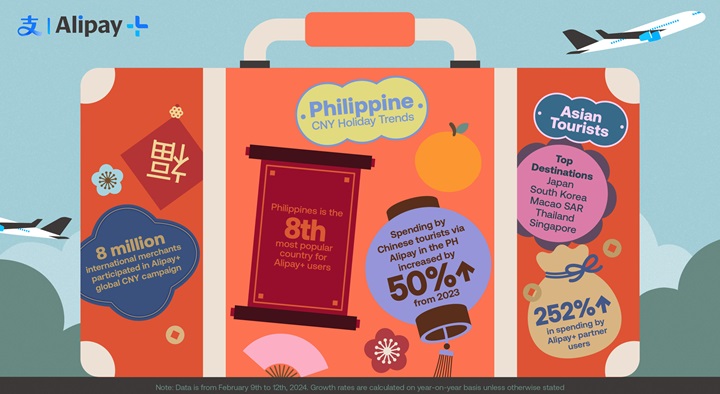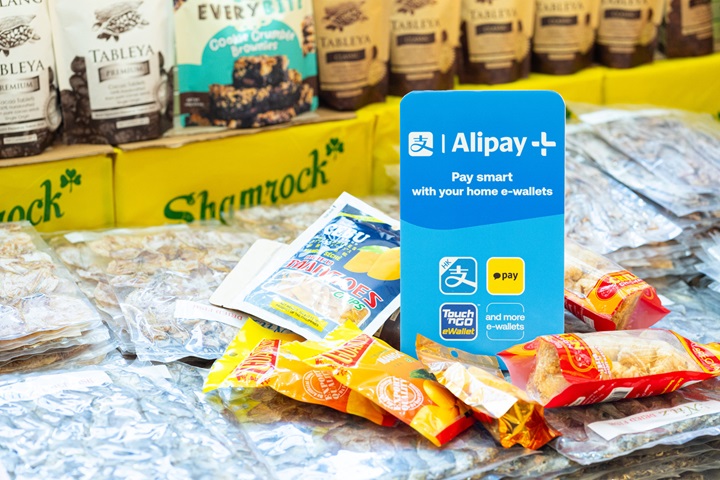- Alipay overseas transactions surpass 2019 numbers
- · According to data from Alipay+, the Philippines is the 8th most popular destination globally for Alipay+ users, with South Korea, Hong Kong, and Malaysia as the top 3 markets
- · Other international e-wallets supported by Alipay+ cross-border mobile payment solutions, as well as international card-enabled Alipay accounts see an inbound travel surge

Data from Ant Group shows a robust rebound of consumer spending during the first back-to-normal Chinese New Year (CNY) travel season after the Covid-19 pandemic, especially in cross-border tourism.
Robust recovery, diversified destinations, and scenarios for Chinese tourists in the region are made possible by Alipay+
Through the Alipay+ cross-border mobile payment technology solutions, travelers may pay for goods, food and beverage, recreation, and entertainment at over 8 million merchants in over 70 countries and regions, all from their familiar home app, without needing to change money or carry cash. On top of this, they can enjoy in-app instant tax refunds, as well as transparent and competitive exchange rates. Within the Philippines, Alipay+ is currently expanding its merchant coverage in Manila and Cebu, the two most popular destinations in the country.
Meanwhile, a global campaign has been in full swing on the Alipay+ merchant network since December 2023 to attract outbound travel for Chinese tourists. In the CNY holiday week between February 9th and 12th, the number of transactions made by Alipay users overseas surpassed that of 2019 by 7 percent while consumer spending recovered to 82 percent of the 2019 level, or 2.4 times of 2023. Compared to last year, spending by Chinese tourists in the Philippines via their home e-wallet, Alipay, particularly increased by 50 percent this year, with shopping as the most popular category. Other than those from the Chinese mainland, tourists from South Korea, Hong Kong and Malaysia are the top three biggest spenders in the Philippines.
Closer socio-economic connections between Hong Kong SAR, Macao SAR, and the Chinese Mainland, the new visa-free policies from major Southeast Asia destinations, and recovering international flight capacities are key enablers of the cross-border travel boom.
Hong Kong SAR, Japan, Macao SAR, Thailand, Malaysia, Singapore, South Korea, France, Australia and Canada are the top destinations for Chinese travelers by their Alipay spending. Thailand, Malaysia and Singapore combined saw a 7.5 percent increase over 2019, and a 580 percent leap over 2023, with Thailand leading in total volume and Malaysia showing the largest increase.
Besides a larger physical parameter, the Chinese globe-trotter is also expanding her interest from traditional activities like shopping and tourism spots-hopping, to more immersive and unique local experience. Globally in the CNY week, Chinese tourists spent 70 percent more on food and beverage than in 2019, venturing from downtown hotspots to out-of-the-way local treasures.
In-town transportation volume grew fast thanks to the passion for “travel local”. Alipay users in multiple destinations now may choose from rail, taxi, rideshare, car rental, bus, subway and even scooter-share when abroad, all from the familiar app on their own phone. The cost per ride on any vehicle for Alipay travelers dropped by 60 percent compared to 2019. A lighter carbon footprint also means more local SMEs on the public transport network gain a share of international tourist revenue.
Promoting cross-border travel among Alipay+ partner e-wallets and bank apps
The Chinese New Year is widely celebrated across Asian communities. With new partnerships in 2023 and increased travel, total cross-border spending on the region’s leading e-wallets powered by Alipay+ increased by 252 percent year-on-year. Daily average transactions increased by 304 percent. Japan, South Korea, Macao SAR, Thailand, and Singapore are the top 5 most popular destinations for Alipay+ consumers besides the Chinese mainland, where the Philippines ranked as the 8th most popular destination globally.
“With its use spreading across age and income groups, increasingly mobile payment is becoming an important promoter of local and cross-border commerce in Asia and beyond, ” said Douglas Feagin, Senior Vice President of Ant Group and Head of Alipay+. “We expect to grow our partnerships with the payment industry leaders, national tourist agencies, and merchants in 2024 to generate more growth. ”

the second biggest gateway of inbound tourists to the Philippines.
Enabled via Alipay+, Alipay (Chinese mainland) has been accepted by local merchants in the Philippines since 2017, while more e-wallets launched locally last year such as, AlipayHK (Hong Kong SAR), Kakao Pay (South Korea), and Touch ‘n Go eWallet (Malaysia). Overall, these e-wallets provide added convenience to tourists, while bringing more growth opportunities to local merchants.
The addition of these new e-wallets ahead of the peak travel season, with a predicted 8.21 million inbound tourists for the Philippines this year, provides a convenient payment experience for tourists while bringing more growth opportunities to local merchants.

